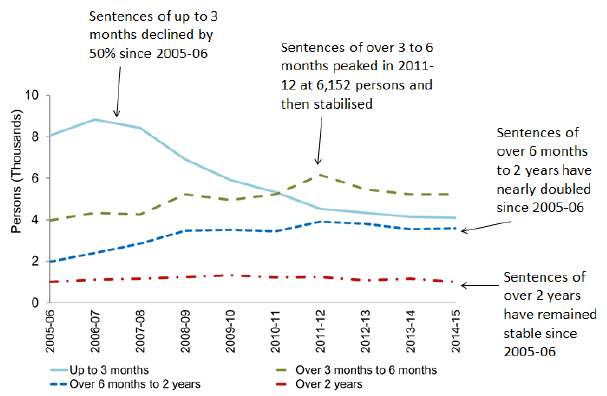CRIMINAL PROCEEDINGS IN SCOTLAND 2014-15
Summary of offences dealt with by courts, sentencing outcomes and characteristics of convicted offenders. Additional information on non-court penalties issued by the Police and Crown Office & Procurator Fiscal Service.
This document is part of a collection
8. Custodial Sentences
Custodial sentences comprise convicted people who are sent to prison or a young offenders institution. The number of custodial sentences fell by 1 per cent in the year to 2014-15 (from 14,142 in 2013-14 to 13,977 in 2014-15). Levels have generally declined since the peak of 16,944 custodial sentences in 2008-09 and are now 18 per cent below that peak. Custodial sentences represented 13 per cent of all convictions in 2014-15. This proportion has remained relatively stable over the last ten years fluctuating between 12 and 15 per cent.
Length of custodial sentences
Sheriffs will consider a number of factors when setting the length of a custodial sentence, including the severity of the offence, whether or not the offender has been convicted before and whether there are any other mitigating circumstances. These statistics do not take into account the factors influencing the sentencing decisions.
Thirty-one of the thirty-two people issued life sentences in 2014-15 were for murder with the remaining one being for rape. When a court imposes a life sentence, a minimum period in custody, called the “punishment part” is set by the court before the prisoner can be considered for release on licence. A life prisoner, if released, will be on licence and subject to recall to prison if they breach the terms of their release licence for the rest of his or her life.
Information on the minimum custodial period of a life sentence is not available from the criminal proceedings database, therefore it is not possible to incorporate these sentences into the average sentence length. The average length of custodial sentences, excluding life sentences, in 2014-15 was around nine and a half months (285 days), which is 8 days (3 per cent) shorter than in 2013-14 (293 days). Over the longer term, between 2005-06 and 2009-10, custodial sentences increased by 23 per cent, from 229 days (7 and a half months) in 2005-06 to 281 days (over nine months) in 2009-10. Since then sentence lengths have remained broadly stable.
The Criminal Justice and Licensing (Scotland) Act 2010 commenced in February 2011 and included a presumption against short sentences (3 months or less). This presumption states that a court must not pass a sentence of imprisonment for a term of 3 months or less on a person unless the court considers that no other method of dealing with the person is appropriate.
Chart 8 illustrates patterns of custodial sentence length by specific categories. In 2005-06 the most common length was “up to 3 months” (8,053 people), which made up 53 per cent of custodial sentences. Over the ten year period levels have dropped by 49 per cent, down to 4,092 people in 2014-15. Sentences of “up to 3 months” now make up 29 per cent of custodial sentences. Please note that sentences of “up to 3 months” started to fall before the presumption was introduced.
Chart 8: Length of Custodial Sentences, 2005-06 to 2014-15

By contrast, custodial sentences of “over 3 to 6 months” and “over 6 months to 2 years” have both risen since 2005-06 as follows:
- Those of “over 3 to 6 months” accounted for 26 per cent of custodial sentences in 2005-05 (3,965 people) and rose to 37 per cent (5,225 people) by 2014-15 to make up the largest proportion of the categories presented.
- Custodial sentences of “over 6 months to 2 years” made up 13 per cent in 2005-06 (1,977 people), rising to 26 per cent by 2014-15 (3,587 people).
The proportion of custodial sentences of “over 2 years”, the longest category of custodial sentence, has remained similar broadly constant over the last ten years, at around 7 per cent of all custodies.
Contact
Email: Gillian Diggins
There is a problem
Thanks for your feedback